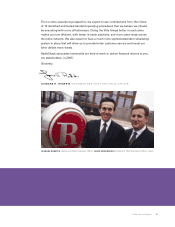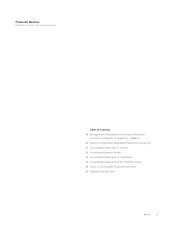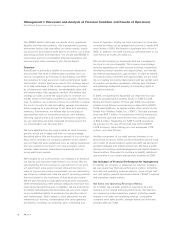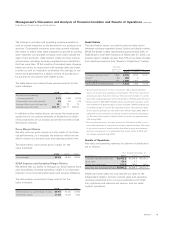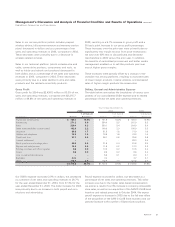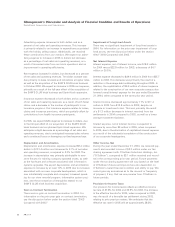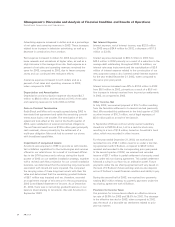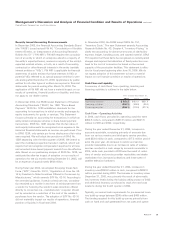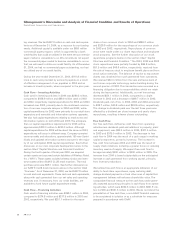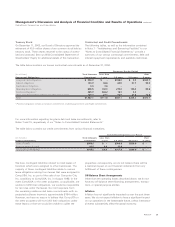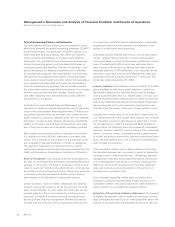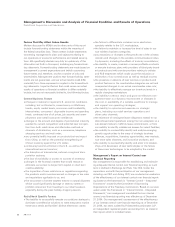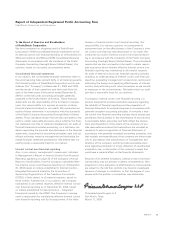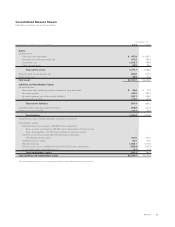Radio Shack 2004 Annual Report Download - page 27
Download and view the complete annual report
Please find page 27 of the 2004 Radio Shack annual report below. You can navigate through the pages in the report by either clicking on the pages listed below, or by using the keyword search tool below to find specific information within the annual report.
Recently Issued Accounting Pronouncements
In December 2003, the Financial Accounting Standards Board
(the “FASB”) issued revised FIN 46, “Consolidation of Variable
Interest Entities, an Interpretation of Accounting Research
Bulletin No. 51” (“FIN 46R”). FIN 46R requires the consolida-
tion of an entity in which an enterprise absorbs a majority of
the entity’s expected losses, receives a majority of the entity's
expected residual returns, or both, as a result of ownership,
contractual or other financial interests in the entity (variable
interest entities or “VIEs”). FIN 46R is applicable for financial
statements of public entities that have interests in VIEs or
potential VIEs referred to as special-purpose entities for peri-
ods ending after December 31, 2003. Applications by public
entities for all other types of entities are required in financial
statements for periods ending after March 15, 2004. The
application of FIN 46R did not have a material impact on our
results of operations, financial position or liquidity, and does
not apply to our dealer outlets.
In December 2004, the FASB issued Statement of Financial
Accounting Standards (“SFAS”) No. 123R “Share-Based
Payment.” SFAS No. 123R establishes standards for the
accounting for transactions in which an entity exchanges its
equity instruments for goods or services. This Statement
focuses primarily on accounting for transactions in which an
entity obtains employee services in share-based payment
transactions. SFAS No. 123R requires that the fair value of
such equity instruments be recognized as an expense in the
historical financial statements as services are performed. Prior
to SFAS 123R, only certain pro forma disclosures of fair value
were required. We will adopt the provisions of SFAS No.
123R beginning with the third quarter of 2005. We intend to
elect the modified prospective transition method, which will
require that we recognize compensation expense for all new
and unvested share-based payment awards from the effective
date. Based on our preliminary analysis of SFAS No. 123R, we
anticipate the after-tax impact of adoption on our results of
operations for the six months ending December 31, 2005, will
be an expense of approximately $6.8 million.
During fiscal year 2004, we adopted Emerging Issues Task
Force (“EITF”) Issue No. 03-10, “Application of Issue No. 02-
16 by Resellers to Sales Incentives Offered to Consumers by
Manufacturers,” which amends EITF No. 02-16. According to
the amended guidance, if certain criteria are met, considera-
tion received by a reseller in the form of reimbursement from
a vendor for honoring the vendor’s sales incentives offered
directly to consumers (i.e., manufacturers’ coupons) should
not be recorded as a reduction of the cost of the reseller’s
purchases from the vendor. The adoption of EITF No. 03-10
did not materially impact our results of operations, financial
position or liquidity in fiscal year 2004.
In November 2004, the FASB issued SFAS No. 151,
“Inventory Costs.” The new Statement amends Accounting
Research Bulletin No. 43, Chapter 4, “Inventory Pricing,” to
clarify the accounting for abnormal amounts of idle facility
expense, freight, handling costs, and wasted material. SFAS
151 requires that these items be recognized as current-period
charges and requires that allocation of fixed production over-
head to the cost of conversion be based on the normal
capacity of the production facilities. This statement is effec-
tive for fiscal years beginning after June 15, 2005. We do
not expect adoption of this statement to have a material
impact on our financial condition or results of operations.
Cash Flow and Liquidity
A summary of cash flows from operating, investing and
financing activities is outlined in the table below.
Year Ended December 31,
(In millions) 2004 2003 2002
Operating activities $ 352.5 $ 651.9 $521.6
Investing activities (290.2) (188.9) (99.0)
Financing activities (259.1) (274.8) (377.5)
Cash Flow – Operating Activities
In 2004, cash flows provided by operating activities were
$352.5 million, compared to $651.9 million and $521.6
million in 2003 and 2002, respectively.
During the year ended December 31, 2004, increases in
accounts receivable, consisting primarily of amounts due
from our various vendors and third-party service providers,
used $53.0 million in cash, compared to $17.2 million provid-
ed in the prior year. An increase in vendor and service
provider receivables due to an increase in sales of wireless
services resulted in a cash usage by accounts receivable in
2004, while cash provided in 2003 was the result of reduc-
tions of vendor and service provider receivables and dealer
receivables from increased collections and lower sales of
satellite television hardware.
During the year ended December 31, 2004, increases in
inventory used $234.2 million in cash, compared to $202.3
million provided during 2003. The increase in inventory since
December 31, 2003, was primarily the result of abnormally
low inventory levels during the holiday selling season of 2003
and additional inventory purchased to stock the new kiosk
locations during the fourth quarter of 2004.
Typically, our annual cash requirements for pre-seasonal inven-
tory build-up range between $200 million and $400 million.
The funding required for this build-up comes primarily from
cash on hand and cash generated from net sales and operat-
Management’s Discussion and Analysis of Financial Condition and Results of Operations continued
RadioShack Corporation and Subsidiaries
25
AR2004


